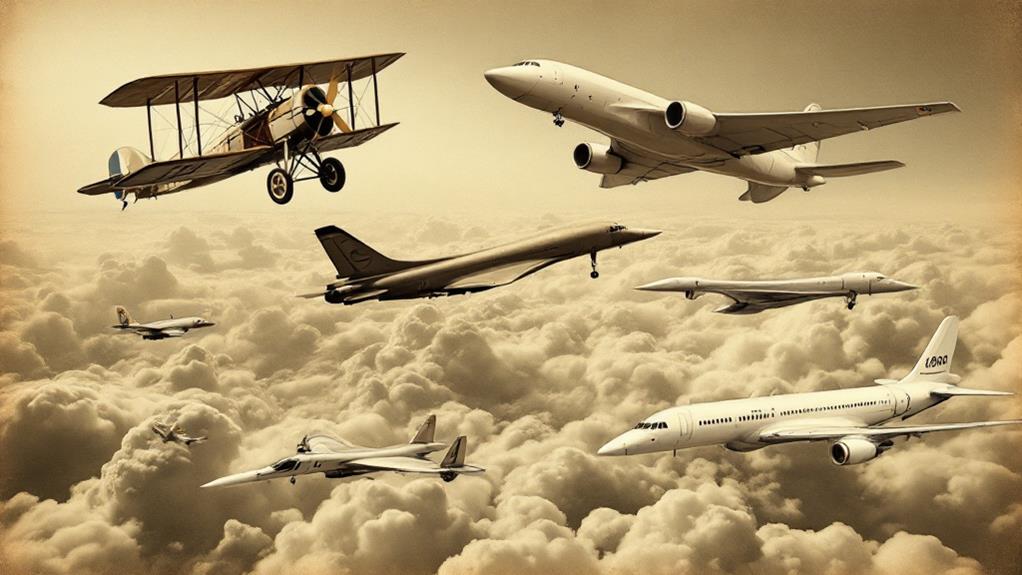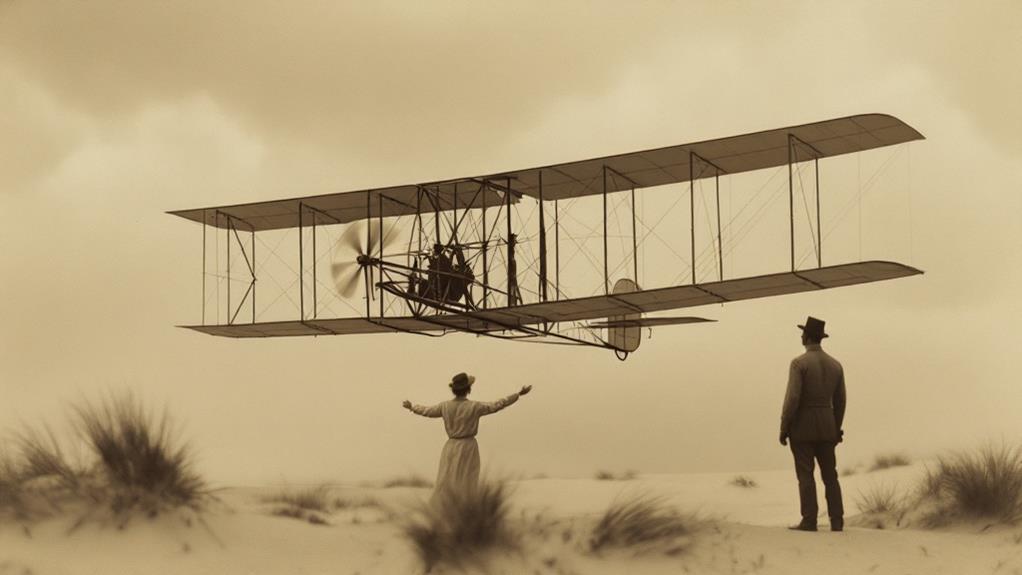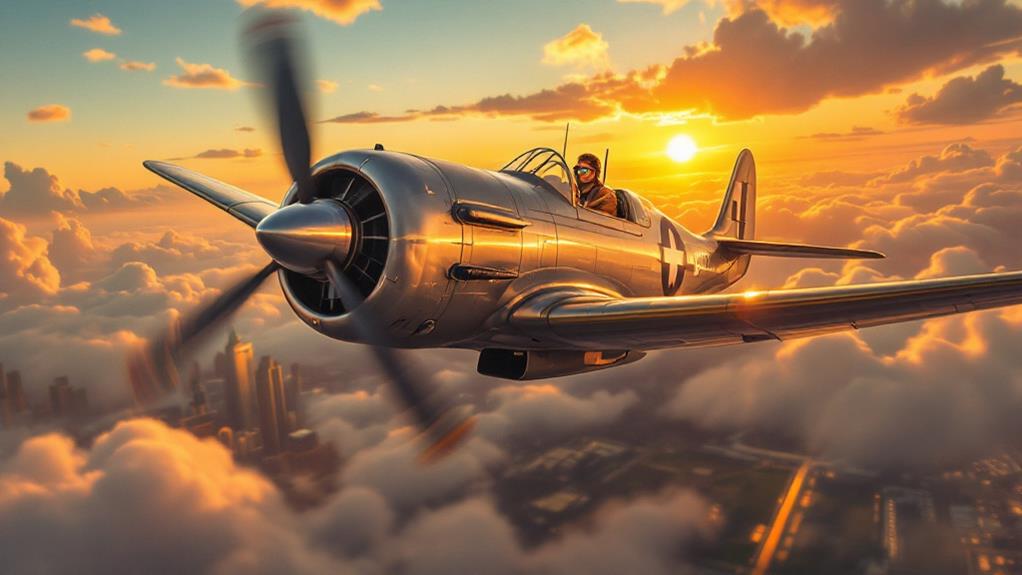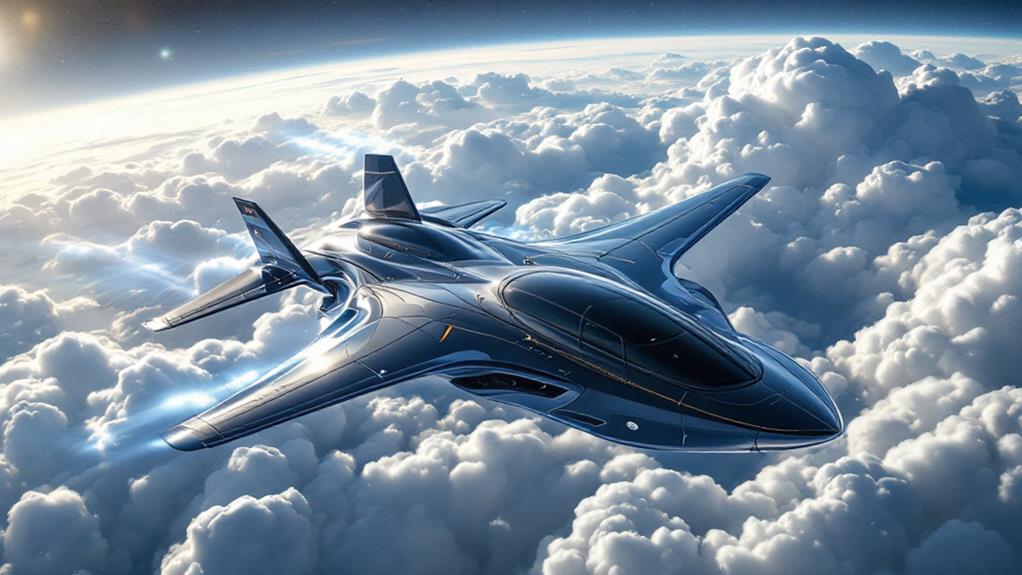The History of Aeronautics: From Early Flight to Modern Aviation

You'll investigate a fascinating expedition through time as you delve into the history of aeronautics, from humanity's earliest dreams of flight to the state-of-the-art technologies of modern aviation. Ancient myths and early experiments gave way to the Wright brothers' breakthrough in 1903. World War I accelerated aerial developments, leading to the Golden Age of Aviation. Jet propulsion revolutionized flight, while the Space Race pushed boundaries even further. Commercial air travel boomed, reshaping global connectivity. Today, aeronautics continues to evolve with autonomous aircraft, sustainable technologies, and dreams of hypersonic travel. The sky's no longer the limit as you soar through this engrossing history.
Ancient Dreams of Flight

Soaring through the skies has enthralled human imagination since ancient times. You'll find evidence of this fascination in mythological stories from various cultures around the world. Greek mythology tells of Icarus and Daedalus, who crafted wings from feathers and wax to escape imprisonment. In Hindu epics, you'll encounter flying chariots called Vimanas, showcasing the universal appeal of flight across civilizations.
Ancient innovators didn't just dream; they tried to turn these visions into reality. You'd be surprised to learn about early attempts at flight, often inspired by bird-like designs. Leonardo da Vinci, the Renaissance polymath, sketched detailed plans for flying machines in the 15th century. His ornithopter concept mimicked bird wing movements, demonstrating a keen understanding of avian flight mechanics.
Chinese inventors experimented with kites and hot air balloons, while others studied glider designs. These early efforts, though unsuccessful in achieving powered flight, laid pivotal groundwork for future developments. They highlighted the importance of lift, drag, and propulsion – concepts that would become fundamental to modern aeronautics. You can trace the roots of today's aviation marvels back to these ancient dreams and daring attempts.
Early Balloon Experiments
Occasionally, dreams of flight took a more buoyant turn with the advent of balloon experiments. You'd be fascinated to learn that the concept of lighter-than-air flight emerged in the late 18th century, revolutionizing the approach to human aviation. The Montgolfier brothers, Joseph-Michel and Jacques-Étienne, pioneered this field with their groundbreaking hot air balloon design in 1783.
Their invention sparked a wave of enthusiasm across Europe, inspiring others to probe the possibilities of balloon flight. You'd find that these early experiments weren't just about ascending into the sky; they were crucial steps in understanding atmospheric conditions, air currents, and the principles of buoyancy. The first manned hot air balloon flight, piloted by Jean-François Pilâtre de Rozier and François Laurent d'Arlandes, marked a significant milestone in aeronautical history.
As you delve deeper into this era, you'll uncover that hydrogen balloons soon followed, offering greater lift and longer flight durations. These early balloon experiments laid the foundation for future developments in aviation, including airships and even aspects of modern aircraft design.
Wright Brothers' Breakthrough

A vital moment in aviation history arrived with the Wright brothers' breakthrough in 1903. Orville and Wilbur Wright's relentless pursuit of powered flight led them to develop innovative techniques that would revolutionize aviation.
You'll find that their odyssey began with extensive glider development. The brothers conducted numerous experiments, refining their designs based on careful observations and data collection. They built a wind tunnel to test wing shapes, gaining pivotal insights into lift and drag.
What set the Wrights apart was their focus on flight control systems. They recognized that controlling an aircraft in three dimensions was essential for sustained flight. Their ingenious solution was the implementation of wing-warping, which allowed the pilot to manipulate the wings' shape for lateral balance. Combined with a movable rudder, this system provided unparalleled control.
On December 17, 1903, near Kitty Hawk, North Carolina, the Wright Flyer made its historic flight. Orville piloted the aircraft for 12 seconds, covering 120 feet. This achievement marked the beginning of controlled, sustained flight in a heavier-than-air machine, ushering in a novel era of aviation and changing the course of history.
World War I Aerial Warfare
The Wright brothers' breakthrough in powered flight set the stage for rapid advancements in aviation technology. As World War I erupted in 1914, you'd see these advancements accelerate dramatically. Aircraft quickly evolved from fragile, unarmed observation platforms to formidable weapons of war.
Initially, pilots used planes for aerial reconnaissance, gathering essential intelligence on enemy troop movements and fortifications. You'd find opposing pilots waving or even shooting pistols at each other in chance encounters. However, this gentlemanly behavior soon gave way to more lethal engagements.
As the war progressed, you'd witness the birth of aerial combat. Planes were equipped with machine guns, and pilots developed dogfighting tactics to outmaneuver and shoot down enemy aircraft. Famous aces like Manfred von Richthofen, the "Red Baron," emerged as national heroes.
Golden Age of Aviation

Following World War I, aviation entered a period of rapid innovation and public fascination known as the Golden Age of Aviation. You'd witness remarkable aircraft design innovations during this era, with sleeker, more aerodynamic planes replacing the biplanes of the war. Engineers focused on creating faster, more efficient aircraft with enclosed cockpits and streamlined fuselages.
Transatlantic flight advancements became a major focus, capturing the world's imagination. You'd see daring aviators like Charles Lindbergh and Amelia Earhart attempting record-breaking flights across the Atlantic. These feats not only pushed the boundaries of aviation technology but also sparked public interest in air travel.
Commercial aviation began to take shape during this period. You'd find airlines emerging, offering passenger services and airmail routes. The development of more reliable engines and directional systems made longer flights possible, establishing the foundation for intercontinental air travel.
The Golden Age also saw the rise of air racing and aerobatic displays, further fueling public enthusiasm for aviation. You'd experience the thrill of watching skilled pilots showcase their abilities in air shows and competitions, inspiring a new generation of aviators and engineers.
Jet Propulsion Revolution
While propeller-driven aircraft dominated the Golden Age, a revolutionary innovative technology was about to change aviation forever. The jet propulsion revolution began in the 1930s with the development of the first jet engines. You'd see rapid advancements in turbine engine development, leading to faster, more efficient aircraft.
During World War II, Germany and Britain raced to create the first operational jet fighters. By the war's end, you'd witness the emergence of jet-powered military aircraft, setting the stage for a novel phase in aviation. In the 1950s, commercial airlines began adopting jet technology, ushering in the age of mass air travel.
The jet age brought unparalleled speed and altitude capabilities. You'd experience the thrill of breaking the sound barrier as supersonic flight capabilities became a reality. The iconic Concorde, introduced in 1976, allowed you to cross the Atlantic in just over three hours. Military jets pushed the boundaries even further, with aircraft like the SR-71 Blackbird reaching speeds of Mach 3+. Jet propulsion revolutionized aviation, shrinking the world and opening new frontiers in both civilian and military applications.
Space Race and Rockets

In the wake of World War II, the Space Race ignited between the United States and the Soviet Union. You'd witness a fierce competition as both nations strove to achieve unparalleled milestones in space investigation. This era saw rapid advancements in rocket propulsion systems and satellite technology, pushing the boundaries of human knowledge and engineering capabilities.
The Space Race led to numerous groundbreaking achievements:
- Launch of Sputnik 1, the first artificial satellite, by the Soviet Union in 1957
- America's response with Explorer 1, their first satellite, in 1958
- Yuri Gagarin's historic orbital flight in 1961, making him the first human in space
- NASA's Apollo program, culminating in the Moon landing in 1969
You'd marvel at the incredible pace of innovation during this period. Rocket technology evolved from simple designs to complex multi-stage vehicles capable of escaping Earth's gravity. Satellite technology advanced rapidly, forming the foundation for global communications, weather forecasting, and Earth observation. The Space Race not only fueled scientific progress but also captured the public's imagination, inspiring generations to dream of the stars.
Commercial Air Travel Boom
As the Space Race enthralled the world, commercial aviation was undergoing its own revolution. You'd see a dramatic shift in air travel during the 1950s and 1960s, as airlines expanded their routes and introduced larger, faster aircraft. The Boeing 707 and Douglas DC-8 ushered in the jet age, drastically reducing travel times and making long-distance flights more accessible.
With this boom came new challenges for the airline industry. Regulations were implemented to guarantee fair competition and maintain safety standards. You'd notice stricter passenger safety protocols being introduced, including mandatory pre-flight safety briefings and the installation of emergency equipment on all aircraft.
As air travel became more affordable, you'd witness a surge in tourism and business travel. Airlines competed fiercely for customers, offering improved in-flight services and amenities. This period also saw the rise of low-cost carriers, further democratizing air travel.
The commercial air travel boom transformed global connectivity, shrinking distances between continents and cultures. You'd experience a world where international travel became commonplace, forever changing how people lived, worked, and traversed the planet.
Future of Aeronautics

Innovation propels aeronautics into an exciting fresh phase. As you look to the skies, you'll see a future where technology and sustainability converge. Self-driving aircraft are no longer confined to science fiction; they're becoming a reality. These autonomous planes will revolutionize air travel, potentially reducing human error and increasing efficiency.
Sustainable fuel sources are at the forefront of aeronautical advancements. You'll witness a shift towards cleaner, renewable energy options that minimize the industry's carbon footprint. Electric and hydrogen-powered aircraft are gaining traction, promising quieter and more environmentally friendly flights.
The future of aeronautics isn't limited to commercial travel. You'll see developments in:
- Urban air mobility with flying taxis
- Hypersonic travel for rapid global transportation
- Space tourism becoming more accessible
- Advanced materials for lighter, stronger aircraft
As you adopt these innovations, you'll experience faster, safer, and more sustainable air travel. The boundaries between Earth and space will blur, opening up new possibilities for exploration and commerce. The future of aeronautics is bright, and you're about to witness a change that will redefine how we move through the skies.



